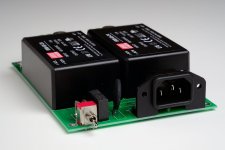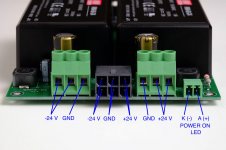Latest member of the Neurochrome product portfolio: SMPS-86.
It's intended to be panel mounted on a panel no thicker than 4.0 mm. International mains in. ±24 V out. 2.85 mV RMS (20 Hz - 20 kHz) output noise.
For more information on the SMPS-86, please see its product page: SMPS-86: Switch-mode power supply for audio amplifiers.
Tom
Well done Tom, the SMPS looks nice.
Having the IEC socket and switch pre-installed is a nice touch. Also like the idea of power LED connecting socket - will make connecting a front panel power LED very easy.
Looks like you have listened well to your customers. 🙂
Attachments
Last edited:
Well done Tom, the SMPS looks nice.
Having the IEC socket and switch pre-installed is a nice touch. Also like the idea of power LED connecting socket - will make connecting a front panel power LED very easy.
Thank you. Mains wiring is intimidating to many, so letting me do that relieves some anxiety for some people.
I rather like the little EURO-style connectors. They're super easy to work with. The mating plug has screw terminals, so you attach your wire there and done! Having the ability to unplug the LED is handy during the assembly stages of a DIY project.
The SMPS-86 saves you 30 % on the parts budget compared to a Power-86 with a 160 VA Hammond toroid that is available world wide.
Looks like you have listened well to your customers. 🙂
I've been known to do that on occasion. 🙂
Tom
I think you understand that I want to power two pair of 90dB B&W speakers with one amp. I'm pretty sure the mod86 won't be capable.
That depends. If the impedance of the speaker is 4 Ω or greater, the Modulus-86 will work fine. The only exception would be if you need to exceed 110 dB SPL.
Would a Parallel-86 work
Certainly. Do beware, though, that the LM4780 is harder to work with than the LM3886. The LM4780 used in the Parallel-86 has a metal back, thus, needs to be isolated from the heat sink. That's not a big deal, but it is certainly in the "do it once and leave it" category of tasks. The SilPad 1500ST thermal pad that I recommend using between the LM4780 and the heat sink won't allow for repeated assembly/disassembly operations.
would the addition of the SMPS-86 with a Mod86 also work?
The SMPS-86 is an alternative to a Power-86 and transformer. The SMPS-86 provides ±24 V. With the right transformer the Power-86 can provide up to ±35 V when used with the Parallel-86; ±28-30 V when used with the Modulus-86.
With the SMPS-86, you will get lower output power. I measure 28 W (8 Ω) just shy of clipping with the LM3886DR. I expect the numbers for the Modulus-86 to be similar. There is no ±30 V or ±36 V module available for the SMPS-86, so you're stuck at ±24 V. That's the drawback.
Tom
I use B&W's (703's) and although these are classed as an 8 ohm nominal load, the impedance actually dips down to 3 ohms. In practice it has never proved a problem but driving two from one amp could get interesting. I would suggest Henry try if possible to obtain an impedance plot of his speakers... and reviews often publish details such as this. Its not that hard to measure anyway given a DVM that can measure low AC voltage and a slow frequency sweep as a test signal. It would certainly give a useful idea what you were dealing with.
I use B&W's (703's) and although these are classed as an 8 ohm nominal load, the impedance actually dips down to 3 ohms. In practice it has never proved a problem but driving two from one amp could get interesting. I would suggest Henry try if possible to obtain an impedance plot of his speakers... and reviews often publish details such as this. Its not that hard to measure anyway given a DVM that can measure low AC voltage and a slow frequency sweep as a test signal. It would certainly give a useful idea what you were dealing with.
Indeed. In example, here is what the late TJN said about your B&W 703's: B&W 703, HTM7, 705, ASW750 surround speaker system Measurements | Sound & Vision
Best,
Anand.
3ohms and 2.7ohms would be typical of a 4 to 8ohms speaker where a 4ohms bass/Mid driver has been used to bring up the bass content to give a "balanced" frequency response when the speakers are not built into a solid wall.
Yeah, life is known to have its wrinkles when your load line turns into an ellipse. In practice, the impedance dips are rarely a problem; unless you need to drive a full-power sine wave at precisely the lowest point of the impedance curve.
Tom
Tom
I use B&W's (703's) and although these are classed as an 8 ohm nominal load, the impedance actually dips down to 3 ohms. In practice it has never proved a problem but driving two from one amp could get interesting.
Driving two speakers in parallel? Why would one do that?
I should probably have asked for clarification, but I assumed Henry was talking about bi-amp (two amps, one speaker) not the other way around.
Tom
late? He posted an article yesterday Calibrating HDR10 | Sound & Vision
Whoops! Too bad I can't correct my post!
Thanks,
Anand.
powering two pair of speakers
I'm a bit confused. For some reason I thought the output of my Mod86 would be increased by using the smps86. What are the benefits of using the smps86 instead of the power86? if there are benefits can I use the Antek AS-3224?That depends. If the impedance of the speaker is 4 Ω or greater, the Modulus-86 will work fine. The only exception would be if you need to exceed 110 dB SPL.
Certainly. Do beware, though, that the LM4780 is harder to work with than the LM3886. The LM4780 used in the Parallel-86 has a metal back, thus, needs to be isolated from the heat sink. That's not a big deal, but it is certainly in the "do it once and leave it" category of tasks. The SilPad 1500ST thermal pad that I recommend using between the LM4780 and the heat sink won't allow for repeated assembly/disassembly operations.
The SMPS-86 is an alternative to a Power-86 and transformer. The SMPS-86 provides ±24 V. With the right transformer the Power-86 can provide up to ±35 V when used with the Parallel-86; ±28-30 V when used with the Modulus-86.
With the SMPS-86, you will get lower output power. I measure 28 W (8 Ω) just shy of clipping with the LM3886DR. I expect the numbers for the Modulus-86 to be similar. There is no ±30 V or ±36 V module available for the SMPS-86, so you're stuck at ±24 V. That's the drawback.
Tom
Driving two speakers in parallel? Why would one do that?
Ah 🙂 well you have read my post in the same way that I read Henrys post. I never mentioned parallel.
I think you understand that I want to power two pair of 90dB B&W speakers with one amp.
Asking the above question made it sound as though this was something a little different to running a stereo pair from a stereo amp.
running two pair
I was asking about using a Mod86 to run a pair of stereo speakers in one room, and another pair in a different room, at the same time.
I think that question has been answered and the Mod86 is not the amp for that application.
For many years I've run a pair of stereo speakers in one room and another pair in a different room at the same time. The various amps used had outputs of 100W, 125W and 200W into 8Ohms. All three had up to double the power into 4Ohms and the big one had lots of power at 2Ohms.
I'm thinking the Parallel86 is the way to go. Am I missing something?
Thanks,
henry
I'll try to clarify my earlier post.Driving two speakers in parallel? Why would one do that?
I should probably have asked for clarification, but I assumed Henry was talking about bi-amp (two amps, one speaker) not the other way around.
Tom
I was asking about using a Mod86 to run a pair of stereo speakers in one room, and another pair in a different room, at the same time.
I think that question has been answered and the Mod86 is not the amp for that application.
For many years I've run a pair of stereo speakers in one room and another pair in a different room at the same time. The various amps used had outputs of 100W, 125W and 200W into 8Ohms. All three had up to double the power into 4Ohms and the big one had lots of power at 2Ohms.
I'm thinking the Parallel86 is the way to go. Am I missing something?
Thanks,
henry
For many years I've run a pair of stereo speakers in one room and another pair in a different room at the same time. The various amps used had outputs of 100W, 125W and 200W into 8Ohms. All three had up to double the power into 4Ohms and the big one had lots of power at 2Ohms.
I'm thinking the Parallel86 is the way to go. Am I missing something?
For background music (so maybe a few watt at the most), either Modulus-86 or Parallel-86 will work. If you really crank it, you'll need the Parallel-86.
Just beware that the LM4780 IC used in the Parallel-86 is getting hard to find at the official distributors due to TI's discontinuance of it. Also note that this Friday (22nd) is your last chance to get in on the Parallel-86 group buy.
Tom
If the more powerful parallel86 will be closer, (seems to have more than twice the output wattage) than the mod86), to my description of the three amps I used. I'm in.
The aspect of the Mod86, I love most, is it's non-fatiguing sound. Even with my other two highly rated amps horns, playing high notes, can sound strident. Large orchestral crescendos can also be hard on the ears and not clearly convey the sounds of individual instruments. One of the amps cost $3,500. Overall I can listen to the Mod86 for hours and it has none of those unpleasant qualities. It sounds great. Great job.
Oh, and after three weeks of listening, to the Mod86, it is now in the cabinet and the other very good amp is for sale.
Oh, and after three weeks of listening, to the Mod86, it is now in the cabinet and the other very good amp is for sale.
Last edited:
Oh, and after three weeks of listening, to the Mod86, it is now in the cabinet and the other very good amp is for sale.
Awesome. Thank you! 🙂
Tom
Your more than welcome. It has been a pleasure, fun and a learning experience working with you.
So, do ya think the Parallel86 will work for me with the two pair of speakers setup in two different rooms? It seem to me the Parallel86 has the power. But, as you well know, I'm new to this whole diy amp thing, so have to rely on people I can trust. You have my undoubted trust.
So, do ya think the Parallel86 will work for me with the two pair of speakers setup in two different rooms? It seem to me the Parallel86 has the power. But, as you well know, I'm new to this whole diy amp thing, so have to rely on people I can trust. You have my undoubted trust.
- Home
- Amplifiers
- Chip Amps
- Modulus-86 build thread

